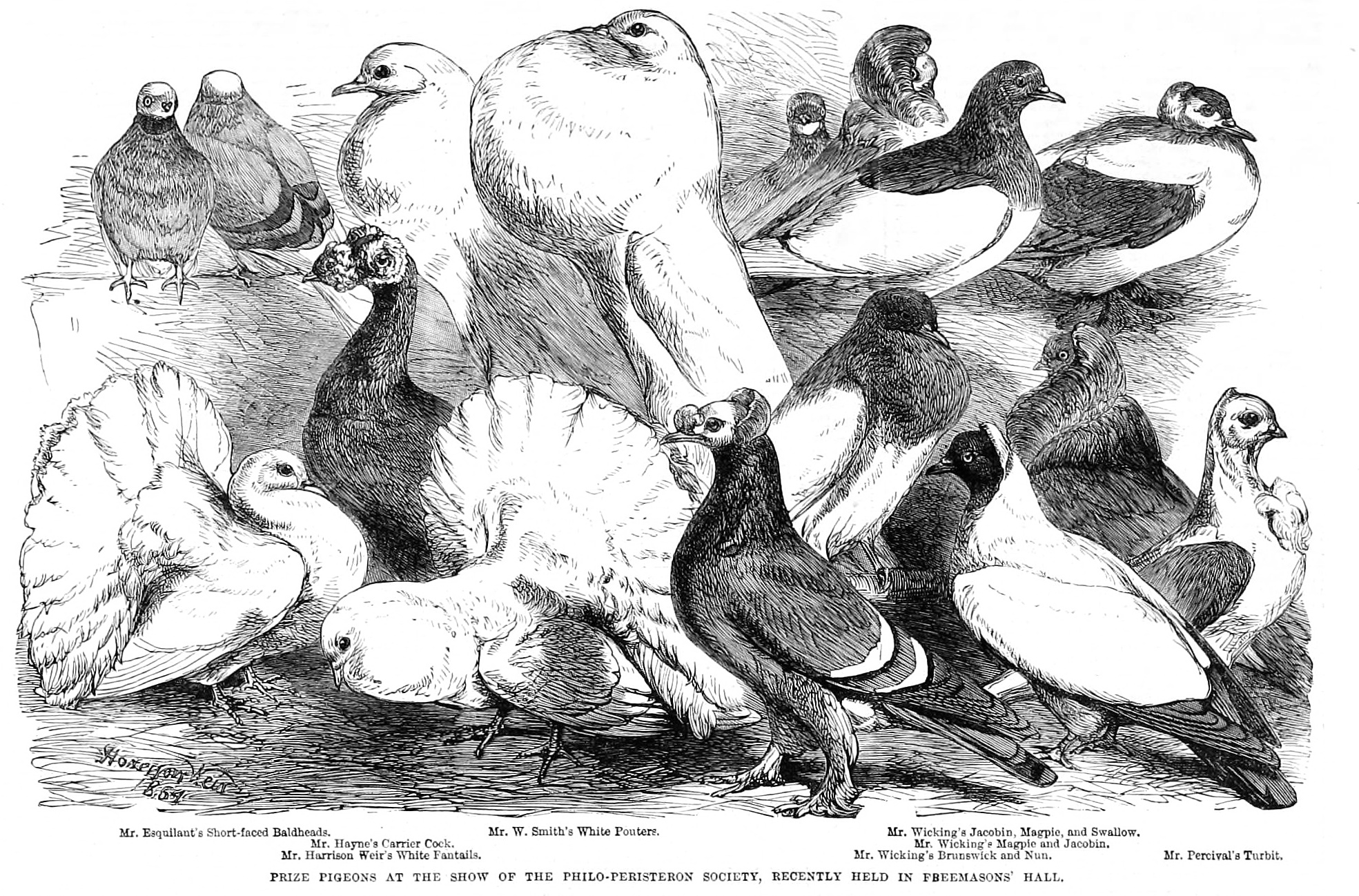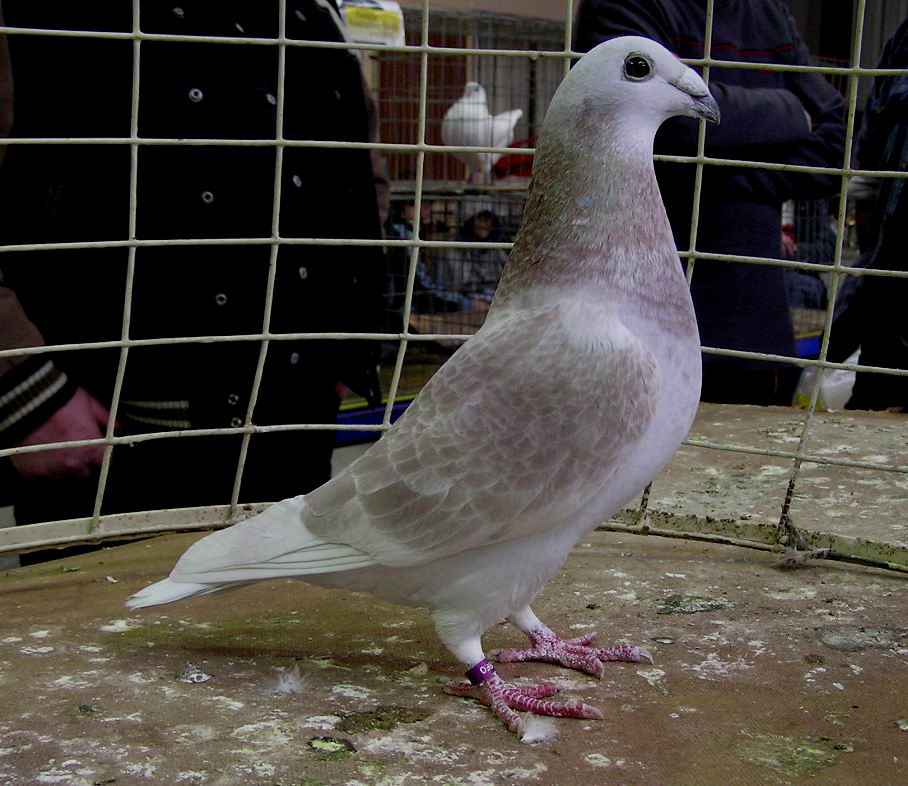|
Saxon Spot(black)
The Saxon Spot (German: Sächsische Schnippe) is a breed of fancy pigeon. Saxon Spots, along with other varieties of domesticated pigeons, are all descendants of the rock dove (''Columba livia''). Appearance The Saxon Spot comes in four color varieties: black, blue, red and yellow. The signature characteristic of the breed is a coloured spot on the top of their head. Their neck is short and their beak is long, with the upper beak being dark blue. The Saxon Spot's feet are well muffed. Their back is broad and their wings rest on the top of the birds tail Origin The Saxon Spot originated in Saxony. See also * List of pigeon breeds *Saxon Shield *Saxon Monk The Saxons ( la, Saxones, german: Sachsen, ang, Seaxan, osx, Sahson, nds, Sassen, nl, Saksen) were a group of Germanic * * * * peoples whose name was given in the early Middle Ages to a large country (Old Saxony, la, Saxonia) near the Nor ... References External links Saxon Spot Standard Pigeon breeds ... [...More Info...] [...Related Items...] OR: [Wikipedia] [Google] [Baidu] |
Saxon Spot(black)
The Saxon Spot (German: Sächsische Schnippe) is a breed of fancy pigeon. Saxon Spots, along with other varieties of domesticated pigeons, are all descendants of the rock dove (''Columba livia''). Appearance The Saxon Spot comes in four color varieties: black, blue, red and yellow. The signature characteristic of the breed is a coloured spot on the top of their head. Their neck is short and their beak is long, with the upper beak being dark blue. The Saxon Spot's feet are well muffed. Their back is broad and their wings rest on the top of the birds tail Origin The Saxon Spot originated in Saxony. See also * List of pigeon breeds *Saxon Shield *Saxon Monk The Saxons ( la, Saxones, german: Sachsen, ang, Seaxan, osx, Sahson, nds, Sassen, nl, Saksen) were a group of Germanic * * * * peoples whose name was given in the early Middle Ages to a large country (Old Saxony, la, Saxonia) near the Nor ... References External links Saxon Spot Standard Pigeon breeds ... [...More Info...] [...Related Items...] OR: [Wikipedia] [Google] [Baidu] |
Breed
A breed is a specific group of domestic animals having homogeneous appearance (phenotype), homogeneous behavior, and/or other characteristics that distinguish it from other organisms of the same species. In literature, there exist several slightly deviating definitions. Breeds are formed through genetic isolation and either natural adaptation to the environment or selective breeding, or a combination of the two. Despite the centrality of the idea of "breeds" to animal husbandry and agriculture, no single, scientifically accepted definition of the term exists. A breed is therefore not an objective or biologically verifiable classification but is instead a term of art amongst groups of breeders who share a consensus around what qualities make some members of a given species members of a nameable subset. Another point of view is that a breed is consistent enough in type to be logically grouped together and when mated within the group produce the same type. When bred together, ind ... [...More Info...] [...Related Items...] OR: [Wikipedia] [Google] [Baidu] |
Fancy Pigeon
Fancy pigeon refers to any breed of domestic pigeon, which is a domesticated form of the wild rock dove (''Columba livia''). They are bred by pigeon fanciers for various traits relating to size, shape, color, and behavior, and often exhibited at pigeon shows, fairs and other livestock exhibits. There are about 800 pigeon breeds; considering all regional varieties all over the world there may be 1100 breeds. The European list of fancy pigeons alone names about 500 breeds. No other domestic animal has branched out into such a variety of forms and colours. Charles Darwin is known to have crossbred fancy pigeons, particularly the Ice Pigeon, to study variation within species, this work coming three years before his groundbreaking publication, ''On the Origin of Species''. Pigeon showing Pigeon fanciers from many different countries exhibit their birds at local, inter-state or national shows and compete against one another for prizes. One typical country show in Australia in 2008 h ... [...More Info...] [...Related Items...] OR: [Wikipedia] [Google] [Baidu] |
Domestic Pigeon
The domestic pigeon (''Columba livia domestica'' or ''Columba livia'' ''forma'' ''domestica'') is a pigeon subspecies that was derived from the rock dove (also called the rock pigeon). The rock pigeon is the world's oldest domesticated bird. Mesopotamian cuneiform tablets mention the domestication of pigeons more than 5,000 years ago, as do Egyptian hieroglyphics. Research suggests that domestication of pigeons occurred as early as 10,000 years ago. Pigeons have made contributions of considerable importance to humanity, especially in times of war. In war the homing ability of pigeons has been put to use by making them messengers. So-called war pigeons have carried many vital messages and some have been decorated for their services. Medals such as the Croix de Guerre, awarded to Cher Ami, and the Dickin Medal awarded to the pigeons G.I. Joe and Paddy, amongst 32 others, have been awarded to pigeons for their services in saving human lives. Despite this, city pigeons today are ... [...More Info...] [...Related Items...] OR: [Wikipedia] [Google] [Baidu] |
Rock Dove
The rock dove, rock pigeon, or common pigeon ( also ; ''Columba livia'') is a member of the bird family Columbidae (doves and pigeons). In common usage, it is often simply referred to as the "pigeon". The domestic pigeon (''Columba livia domestica'', which includes about 1,000 different breeds) descended from this species. Escaped domestic pigeons have increased the populations of feral pigeons around the world. Wild rock doves are pale grey with two black bars on each wing, whereas domestic and feral pigeons vary in colour and pattern. Few differences are seen between males and females. The species is generally monogamous, with two squabs (young) per brood. Both parents care for the young for a time. Habitats include various open and semi-open environments. Cliffs and rock ledges are used for roosting and breeding in the wild. Originally found wild in Europe, North Africa, and western Asia, pigeons have become established in cities around the world. The species is abundant, ... [...More Info...] [...Related Items...] OR: [Wikipedia] [Google] [Baidu] |
Saxony
Saxony (german: Sachsen ; Upper Saxon: ''Saggsn''; hsb, Sakska), officially the Free State of Saxony (german: Freistaat Sachsen, links=no ; Upper Saxon: ''Freischdaad Saggsn''; hsb, Swobodny stat Sakska, links=no), is a landlocked state of Germany, bordering the states of Brandenburg, Saxony-Anhalt, Thuringia, Bavaria, as well as the countries of Poland and the Czech Republic. Its capital is Dresden, and its largest city is Leipzig. Saxony is the tenth largest of Germany's sixteen states, with an area of , and the sixth most populous, with more than 4 million inhabitants. The term Saxony has been in use for more than a millennium. It was used for the medieval Duchy of Saxony, the Electorate of Saxony of the Holy Roman Empire, the Kingdom of Saxony, and twice for a republic. The first Free State of Saxony was established in 1918 as a constituent state of the Weimar Republic. After World War II, it was under Soviet occupation before it became part of the communist East Ger ... [...More Info...] [...Related Items...] OR: [Wikipedia] [Google] [Baidu] |
List Of Pigeon Breeds
This is an alphabetical list of pigeon breeds. Pigeons and doves are members of the bird family Columbidae. Doves tend to be smaller and pigeons larger, although this distinction is not consistently applied. The birds listed here are breeds of the domestic pigeon (''Columba livia domestica''). Other Columbidae species (e.g., the domesticated Barbary dove, ''Streptopelia risoria'') have been developed into breeds, but these are generally simple colour variations. See also List of Columbidae species. A * Aachen Cropper (D/326)Entente Européenne d’ Áviculture et de Cuniculture (2012)''EE-List of the Breeds of Fancy Pigeons'' (ELFP) * Aachen Lacquer Shield Owl pigeon (= Aachen Luster Shield,Encyclopedia of Pigeon Breeds''List of Pigeon Breeds''/ref> ELFP-No. D/705; = Aachen Shield OwlNational Pigeon Association (2014)(table of contents by name)) * Aargae Peak-crested * Abu Abse-Dewlap (D/063) * African Owl pigeon (GB/710) * Agaran Pigeon (RUS(D)/893) * Alpine Swift pigeon * Alsac ... [...More Info...] [...Related Items...] OR: [Wikipedia] [Google] [Baidu] |
Saxon Shield
The Saxon Shield is a breed of fancy pigeon. Saxon Shields, along with other varieties of domesticated pigeons, are all descendants from the rock pigeon (''Columba livia''). Appearance The Saxon Shield comes in many colors including black, blue, red and yellow with white bars or spangles, blue with black bars or barless, blue check or silver check. Origin The Saxon Shield originated in Saxony. See also *List of pigeon breeds This is an alphabetical list of pigeon breeds. Pigeons and doves are members of the bird family Columbidae. Doves tend to be smaller and pigeons larger, although this distinction is not consistently applied. The birds listed here are breeds of th ... * Saxon Spot * Saxon Monk External links Saxon Shield Standard {{Domesticated-pigeon-breed-stub ... [...More Info...] [...Related Items...] OR: [Wikipedia] [Google] [Baidu] |
Saxon Monk
The Saxons ( la, Saxones, german: Sachsen, ang, Seaxan, osx, Sahson, nds, Sassen, nl, Saksen) were a group of Germanic * * * * peoples whose name was given in the early Middle Ages to a large country (Old Saxony, la, Saxonia) near the North Sea coast of northern Germania, in what is now Germany. In the late Roman Empire, the name was used to refer to Germanic coastal raiders, and as a name similar to the later "Viking". Their origins are believed to be in or near the German North Sea coast where they appear later, in Carolingian times. In Merovingian times, continental Saxons had been associated with the activity and settlements on the coast of what later became Normandy. Their precise origins are uncertain, and they are sometimes described as fighting inland, coming into conflict with the Franks and Thuringians. There is possibly a single classical reference to a smaller homeland of an early Saxon tribe, but its interpretation is disputed. According to this proposal, the ... [...More Info...] [...Related Items...] OR: [Wikipedia] [Google] [Baidu] |






